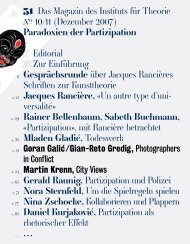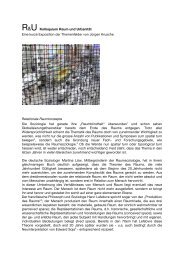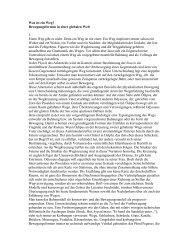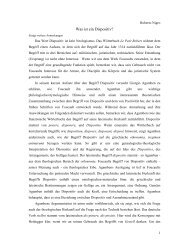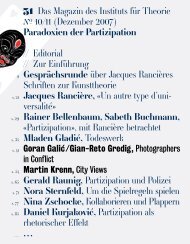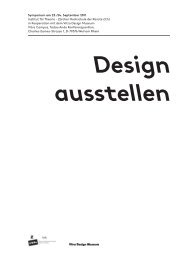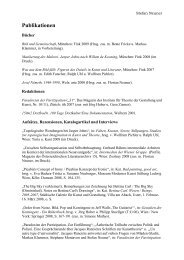Heft - Institut für Theorie ith
Heft - Institut für Theorie ith
Heft - Institut für Theorie ith
Erfolgreiche ePaper selbst erstellen
Machen Sie aus Ihren PDF Publikationen ein blätterbares Flipbook mit unserer einzigartigen Google optimierten e-Paper Software.
Mladen<br />
Dollar<br />
89<br />
One<br />
Splits<br />
into<br />
Two<br />
To be sure, language constantly attempts<br />
to capture the sexual di≠erence by its<br />
means, and perhaps this defines a very<br />
basic linguistic gesture. The most general<br />
classification of nouns, in most languages,<br />
follows precisely the sexual pattern<br />
in order to establish the roughest of<br />
divides, that into masculine and feminine<br />
gender. This opposition, supposedly<br />
taken from nature, is used as the<br />
most elementary guideline to sort out<br />
the vocabulary. But the spectacular<br />
metonymic proliferation in all directions<br />
testifies to the impossibility of the<br />
task. When anything can be grammatically<br />
sexed, then nothing can be, and<br />
the very instrument of such classification<br />
is ruined by its own success. In<br />
François Tru≠aut’s Jules et Jim there is<br />
a famous line where Oskar Werner, as a<br />
German, tells Jeanne Moreau (not merely<br />
a French woman, but a French woman<br />
par excellence): “What a strange language<br />
is French where ‘l’amour’ is masculine<br />
and ‘la guerre’ feminine!” In German,<br />
w<strong>ith</strong> “die Liebe” and “der Krieg,” it<br />
is the opposite, supposedly how it should<br />
be if we are to follow “a natural pattern.”<br />
In Germany love is the domain of women<br />
and war is the domain of men, while<br />
in France, reputed for its hang for perversion,<br />
it seems to be the other way<br />
round. “Make love not war!” would have<br />
a completely di≠erent meaning and<br />
impact in Germany or in France. So taking<br />
the sexual di≠erence as the pattern<br />
of grammatical gender makes for the<br />
general confusion. The infinite possibilities<br />
of extension in any direction<br />
make the di≠erence flourish, while the<br />
guiding principle becomes completely<br />
blurred. Everything can be accounted<br />
for, and squeezed into the mold, in terms<br />
of gender, except for the sexual difference<br />
itself which serves as the model.<br />
The di≠erence on which everything may<br />
be modeled persists as a real which cannot<br />
itself be seized as a di≠erence. 14<br />
If there is a real of sexual di≠erence, a<br />
real which makes for its two, irreducible<br />
to the two of count or the expansion of<br />
One, then it can be most simply and<br />
economically epitomized by Lacan’s<br />
dictum: “There is no sexual relation” / “Il<br />
n’y a pas de rapport sexuel.” There is a<br />
two, but there is no relation. The program<br />
for this series on the Figure of Two<br />
invoked among other things the image<br />
of the two, the satisfaction or the spell<br />
provided by a symmetrical image, a<br />
doubling structuring the image. Perhaps<br />
the best known figure of such an<br />
image is the image of yin-yang and its<br />
disposition in the Tao sign. It is an<br />
image which has massively served as<br />
support for an entire cosmology, ontology,<br />
social theory, astronomy. It gives<br />
figure precisely to the two (and only<br />
two) poles of masculine and feminine,<br />
and the image is formed in such a way<br />
that they complement and complete<br />
each other, in perfect symmetry. There<br />
is a circle, and the circle itself is divided<br />
by the half-circle lines. The masculine<br />
and the feminine principle, their conflictual<br />
complementarity, are taken as the<br />
clue which informs every entity, indeed<br />
the entire universe. What does this image<br />
convey? There is a strong thesis presented<br />
in it which one could spell out<br />
like this: there is a relation. There is a<br />
sexual relation. Every relation is sexual.<br />
The relation exists emphatically, conspicuously,<br />
in a demonstrative manner,<br />
in the complementarity of the masculine<br />
and the feminine, in their perfect<br />
balance, the perfect match, and can<br />
serve as a paradigm for everything else.<br />
Everything can be interpreted in the<br />
light of this image. This thesis implies<br />
and manifests even more: there is sense.<br />
The image serves as the visual embodiment<br />
of sense that can provide everything<br />
else w<strong>ith</strong> sense. Sense consists in<br />
the relation. The paradigm that regulates<br />
sense also regulates the sexual<br />
relation. 15 It has the power to bestow<br />
sense, stemming from the two. So this<br />
sign states: one divides into two, and<br />
the two merge into one. Exactly the<br />
opposite from the other notorious Chinese<br />
dictum: one divides into two, but<br />
two does not merge into one. For Lacan<br />
the Aristotelian ontology is like our<br />
western version of yin-yang, it makes<br />
analogous assumptions about ὕλη and<br />
μoρφή, matter and form, the feminine<br />
and the masculine. Ontology is always<br />
secretly sexualized, it is premised on<br />
the hidden assumption about the relation.<br />
16 So the thesis that there is no<br />
sexual relation implies a strong ontological<br />
thesis: there is an irreducible<br />
two, but no relation, not even, and especially<br />
not, the relation of count. There is<br />
the Other (of the unconscious, of sex),<br />
but it cannot be counted for one. It lacks,<br />
it does not exist, but nevertheless, and<br />
this is the whole problem, its non-existence<br />
does not amount to a simple zero,<br />
a nothing.<br />
What, if anything, is the Other? Of what<br />
the Other is the name? It is the Other of<br />
the symbolic, but naming the locus<br />
where the symbolic slips – the Other is<br />
the Other of the bug, not of the order –<br />
and this is the place where the unconscious<br />
sneaks in and where the subject<br />
of desire takes its slippery hold. And the<br />
Other is the Other of sex, of the body, of<br />
enjoyment, the surplus enjoyment, the<br />
drive, the partial objects, the heterogeneous<br />
excess which is the bug of sexuality<br />
and can never be assigned to its<br />
place. Those are the two directions of<br />
the initial discovery of psychoanalysis,<br />
and the notion of the Other takes them<br />
together under the same roof, it names<br />
together, under one heading, in the<br />
same framework, that which in language<br />
and in the body presents both<br />
lack and excess. And this lack / excess<br />
emerges precisely at the interface of<br />
bodies and languages, at the interface<br />
of these countable entities, at their<br />
overlapping, their infringing of one<br />
upon the other.<br />
14 - The same goes for the difference<br />
between activity as masculine<br />
and passivity as feminine, the<br />
common image describing the<br />
sexes, which greatly preoccupied<br />
Freud. In the New<br />
Introductory Lectures he speaks<br />
about this spontaneous<br />
assumption and advises against<br />
it: “Es erscheint mir unzweckmäßig<br />
und es bringt keine neue<br />
Erkenntnis,” Sigmund Freud,<br />
“Neue Folge der Vorlesungen zur<br />
Einführung in die Psychoanalyse,”<br />
in: Freud, Studienausgabe<br />
(note 8), vol. 1, p. 547. This is an<br />
imaginary difference, an image<br />
that we impute to sex, which<br />
may be telling, but it is not an<br />
affair of knowledge.<br />
15 - Lacan comments briefly on<br />
yin-yang in The Four Fundamental<br />
Concepts of Psycho-Analysis,<br />
Harmondsworth 1977, p. 151.<br />
16 - See Lacan, Encore (note 9), p. 76.



